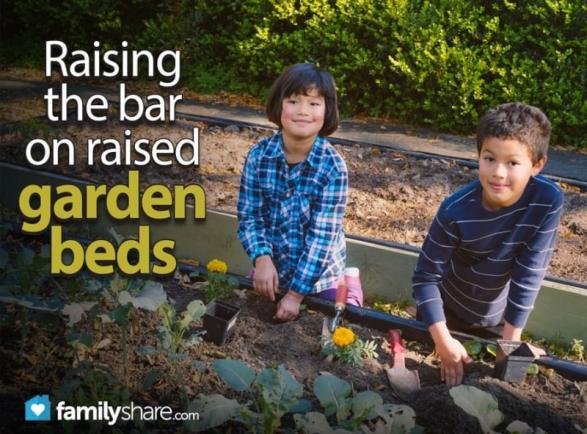
Spring is here. You and the family are itching to get out and enjoy the longer days and find the flowers, fresh fruits and vegetables April showers promise. You realize a garden is what you need. Home vegetable and flower gardens don't require acres of land, hours of maintenance or back breaking work. All they need is a family working together to reap the benefits of the coming summer. One type of home garden uses raised beds which provide better drainage and weed control, higher yields, improved water usage and are easier for the physically challenged to manage.
Rocks, bricks, concrete blocks, interlocking blocks, composite plastic timber, wood and pallets are all great materials for a raised bed garden. Desired look, cost, time and available space will play a major role in which material(s) you chose for your garden creation.
Rocks, bricks and interlocking blocks
These are among the most versatile, so gather the family, break out their imaginations and create. These are also among the more costly materials which could be offset by the increase in appeal and property value.
Wood
Wood is the most common material used and should be held together with galvanized or stainless steel screws or bolts. The best types of wood are cedar or redwood as recommended in the article, "The perfect raised bed."� These woods are rot resistant. Stay away from preserved woods, such as creosote-treated railroad ties. They contain toxins not compatible with food stock. Pressure treated wood with alkaline copper quaternary, ACQ is debatable as to its safety, but definitely unusable for those wishing to raise organic fruits and vegetables.
Composite plastic timber
This is one way to be "green" and still have the look of wood. Made of wood and recycled polyethylene, this timber is great for all seasons. It's perfect for raised bed gardens because it doesn't rot and resists warping. They're also more convenient than wood because they can be purchased pre-made for your desired garden bed. Here's a pdf file with great information and comparison between composite plastic timber and wood.
Concrete or cement blocks
I've found the 8x8x16 inch hollow blocks to be the easiest with which to build due to the fact they are reasonably priced, lighter in weight and easiest to acquire. I've also found they require the least amount of work when it comes to placing them to create your garden bed. They do not require mortar and, in most cases, removal of soil or objects that prevent their sitting flat and level is only required for a few of the blocks. These are the best choice for growing organic foods and flowers. "Concrete raised garden beds are easy to build and fairly cheap."�
Pallets
Pallets require the least amount of time and can be quick and easy. Confirm the pallet is heat treated, HT, and preferably new as recommended in "Creating a Pallet Garden."� If you want to recycle and pick up some used pallets, clean them with bleach, or soap and water to clean away any possible chemicals that may have been stored on them. Pallets can be laid flat or vertical. If you plan to use your pallet vertically you'll also need a stapler and landscape fabric to keep the soil in the pallet as demonstrated in the article, "How to Make a Recycled Pallet Vertical Garden."� Vertical pallets are great for small spaces, but must be monitored closely due to the fact they dry out quicker than other garden types.
Building your beds
Most recommend bed sizes to be 3 to 4 feet wide and as long as you desire. This permits ease in weeding and working with the plants. The height should be 1 to 2 feet. Three feet is OK but requires a lot more compost and soil. Multiple beds permit greater crop yields, choices, and for rotation. Be sure to leave a minimum of 18 inches between beds unless you desire passage of a mower or wheelbarrow, in which case you'll need 2 feet.
Place the beds in a sunny location, preferably orientated north to south. If your location is damp or soggy, dig out about 3 to 4 inches down and replace with pea gravel or a course stone and cover with landscape fabric. Another consideration, to keep out vermin, is to place hardware cloth down before filling with soil.
Other convenient additions would be netting to keep out the birds and flying insects, clear polyethylene to raise the temperature and allow for earlier starts and an automatic watering system that waters your garden in the morning. These additions, although not necessary, will leave you to the planting, weeding, harvesting and will give the plants a more consistent source of water at the best time of the day for better yields and health.
Follow Michelle Obama's example. Gather the family, get some sun (don't forget the sun block), exercise and involve them in all steps from designing to planting to harvest. Reap the benefits and watch their amazement as they harvest the fruits of their hard work and possibly eat vegetables they may have turned down in the past.

